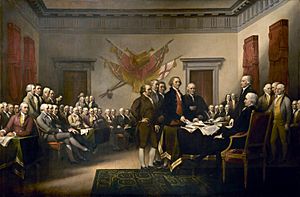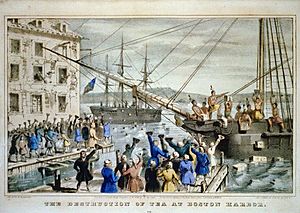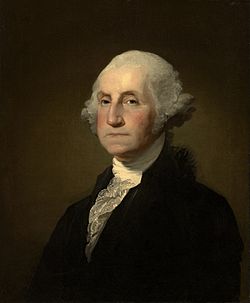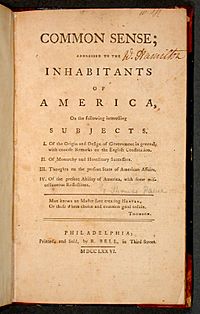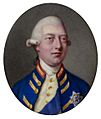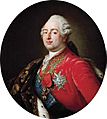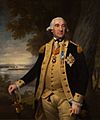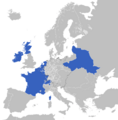American Revolution facts for kids
The American Revolution is the series of events, ideas, and changes that resulted in the creation of the United States of America. Before the revolution, the thirteen colonies in North America had been politically controlled by the British Empire. The American Revolutionary War (1775–1783) was one part of the revolution, but the revolution began before the first shot was fired at Lexington and Concord and continued after the British surrender at Yorktown. Most historians agree that the revolution began around the time of the French and Indian War (1754–1763) and ended with the election of George Washington as the first President of the United States in 1789.
Contents
Origins
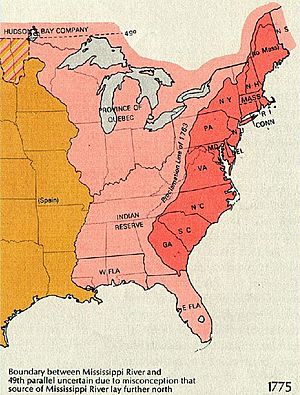
Main article: Colonial America
In the early 1760s, Great Britain possessed a vast empire on the North American continent. In addition to the thirteen British colonies, victory in the Seven Years' War had given Great Britain claim over New France (Canada), Spanish Florida, and the Native American lands east of the Mississippi River. A war against France's former Indian allies - Pontiac's Rebellion - had settled things down in the western frontier. Most white colonists in America considered themselves loyal subjects of the British Crown, with the same rights and duties as people in Britain.
Religious trends
The Great Awakening caused people to question the authority of established religious institutions, especially, but not only, the Church of England. The revival placed authority on Scripture rather than tradition.
Road to rebellion
After the French and Indian War and Pontiac's Rebellion, newly crowned King George III wanted to make sure England still strongly controlled the land and economic state of North America. He created new economic and land distribution policies. The colonists did not like these new policies and, over time, grew increasingly dissatisfied with how much control the British Crown had over them from across the ocean. They began to want to rule themselves.
Economic disputes, 1760-70
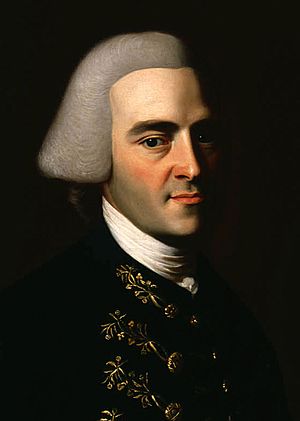
In 1760, the Crown began looking for more ways to get money from the colonies to help pay the British national debt. Britain thought this was okay because the colonists were enjoying the benefits of living in peace in the New World.
Britain had already passed the Navigation Acts, which meant that England controlled ships, shipping, trade, and commerce between other countries and with its own colonies. However, the colonists had found ways to avoid the laws, and England did not like this. They began strictly enforcing the Navigation Acts by using open-ended search warrants called the Writs of Assistance.
In 1764, more taxes were added to the colonists. British Prime Minister George Grenville's Sugar Act and Currency Act led to protests and the boycott of British goods. The colonists did not think that Parliament should be able to tax them if they were not also represented in Parliament by their citizens. They believed that only their colonial assemblies had the right to tax them. The slogan "no taxation without representation" became popular. Committees of correspondence were formed in the colonies to coordinate resistance to the tyrannical British rule.
In 1765, Grenville passed the Stamp Act as a way to pay for places for British troops to stay in North America. The Stamp Act required all legal documents, permits, commercial contracts, newspapers, pamphlets, and playing cards in the colonies to carry a tax stamp.
Protests took place throughout the colonies. Secret societies known as the Sons of Liberty were formed in every colony. The Stamp Act Congress was formed, which sent a formal protest to Parliament in October of 1765. Parliament did repeal the Stamp Act (reverse the law), but they immediately followed with the Declaratory Act. This stated that the Parliament's authority was the same in America as in Britain and that Parliament had the authority to pass laws that the colonies had to follow.
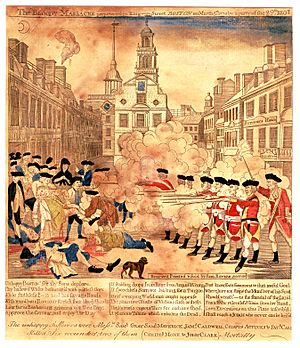
In 1767, Parliament passed the Townshend Acts. These acts placed taxes on common goods that were imported to the colonies, including glass, paint, lead, paper, and tea. This was also intensely disliked among the colonies. Colonial leaders organized boycotts of these British imports. British customs officials seized the Liberty, a ship belonging to the colonial merchant John Hancock, on June 10, 1768, because they suspected him of smuggling goods to the colonies. This led to more angry protests in the street.
British customs officials reported to London that Boston was in a state of insurrection. By October of 1768, British troops arrived in Boston. The colonists did not appreciate having British troops in their town. On March 5, 1770, British soldiers of the 29th Regiment of Foot fired into an angry mob, killing five people. This is called the Boston Massacre.
Though the Townshend Acts were repealed in 1770, the British tried to show that they still had power over the colonies by keeping the tax on tea. For the revolutionaries, who firmly believed that only their colonial representatives could charge them taxes, it was still one tax too many.
Western land dispute
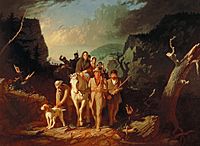
The Proclamation of 1763 said that settlers could not settle west of the Appalachian Mountains. However, groups of settlers, some led by Daniel Boone, continued to settle further west and fought with the Shawnees and other peoples already living in the area.
The Quebec Act of 1774 extended Quebec's boundaries to the Ohio River. It also reestablished French civil law and required people to tolerate Roman Catholics in that territory.
Crises, 1772-75
- Gaspée Affair
- Tea Act of 1773
- Boston Tea Party, December 16, 1773
- "Intolerable Acts" of 1774
- The First Continental Congress met on September 5, 1774, in Philadelphia, Pennsylvania, and endorsed the Suffolk Resolves, which declared the Intolerable Acts to be unconstitutional, called for the people to form militias, and called for Massachusetts to form a revolutionary government. Joseph Galloway's Plan of Union was defeated.
- Battle of Lexington and Concord, April 19, 1775
- The Second Continental Congress convened on May 10, 1775
- The Olive Branch Petition sent on July 5, 1775, was one final attempt by the Continental Congress to appeal to King George to redress their grievances and avoid more bloodshed. The King refused even to receive the petition.
Choosing sides
The American revolutionaries were known as Patriots (or Whigs or rebels). Though they agreed that England had too much power over them, did not all believe exactly the same way. Alexander Hamilton, John Jay, and George Washington are remembered for wanting to keep the wealth and power among the "better sorts" of colonial society. Thomas Jefferson, James Madison, Benjamin Franklin, and Thomas Paine are remembered for representing those who were not as wealthy or powerful in society.
Many American colonists stayed loyal to the British Crown. They were known as Loyalists (or Tories or King's men). Like the revolutionaries, this group was also made up of both the rich and poor of society.
War for independence, 1775-83
Main article: American Revolutionary War
Thomas Paine produced a pamphlet entitled Common Sense, arguing that the only solution to the problems with Britain would be republicanism and independence.
America after the war
- Shays' Rebellion (1786)
- Northwest Indian War (1785-1795)
- The Constitutional Convention of 1787
The American Revolution brought several important changes:
- It introduced the separation of church and state, which ended the special privileges of the Anglican Church in the South and the Congregationalist Church in New England.
- It showed that the government should be for the people and that if the people are not happy with their representatives, they have the right to rebel against tyranny.
- It assigned power through written constitutions.
- It showed that the colonists in America could become self-governing nations.
Revolution beyond America
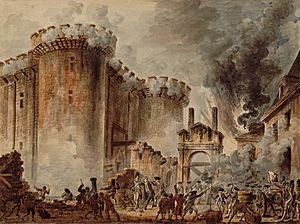
The American Revolution set an example for the people in Europe and other parts of the world. For the first time in the western world, a people had successfully overthrown the rule of a major country. The thinkers of the Enlightenment had only written that common people had the right to overthrow unjust governments. The American Revolution proved that it could be done. It encouraged the people to fight for their rights.
Other revolutions followed, like the French Revolution, the Haitian Revolution, and the Latin American wars of liberation. Smaller versions of revolution could also be found in Ireland in the 1798 rising, in the Polish-Lithuanian Commonwealth, and in the Netherlands.
In the early 19th century, revolutions broke out in the colonies in South America against Portugal and Spain. Years later, similar revolutions occurred in Asia and other places.
Interesting Facts about the American Revolution
- The British did all they could to keep their power over the colonists by passing laws that the colonists had to follow:
- The Navigation Acts
- The Proclamation of 1763
- The Sugar Act
- The Currency Act
- The Stamp Act
- The Quartering Act
- The Declaratory Act
- The Townshend Acts
- The Tea Act
- The Intolerable Acts (known in Britain as the Coercive Acts)
- Many colonists were not angry because of the taxes they had to pay but because they were not represented in Parliament. Later, the Americans taxed themselves at higher rates than the British did, but they had representatives in government.
- Benjamin Franklin traveled to England to ask for a truce. He was mocked and returned home a Patriot.
- Doctor James Jay (brother of Founding Father John Jay) created an “invisible ink” made out of ferrous sulfate and water that could be used to write secret messages and would dry completely clear. The message was held to heat or wet with a chemical to read it.
- British soldiers were called "Red Coats."
- The Declaration of Independence does not have the word "independence" in it.
- In 1776, a secret committee discovered a plan to kill George Washington. The plan was led by his bodyguard, Thomas Hickey.
- The Treaty of Paris formally recognized the United States as an independent nation.
Images for kids
-
New borders drawn by the Royal Proclamation of 1763
-
Notice of the Stamp Act 1765 in a colonial newspaper
-
Letter III of John Dickinson's Letters from a Farmer in Pennsylvania, published in the Pennsylvania Chronicle, December 1767
-
On June 9, 1772, the Sons of Liberty burned HMS Gaspee, a British customs schooner in Narragansett Bay
-
The December 16, 1773 Boston Tea Party, led by Samuel Adams and Sons of Liberty, has become a mainstay of American patriotic lore.
-
Join, or Die, a political cartoon attributed to Benjamin Franklin was used to encourage the Thirteen Colonies to unite against British rule
-
The British fleet amassing off Staten Island in New York Harbor in the summer of 1776, depicted in Harper's Magazine in 1876
-
The Staten Island Peace Conference in September 1776 depicted in a drawing by Alonzo Chappel
-
Washington crossing the Delaware on December 25–26, 1776, depicted in Emanuel Leutze's 1851 painting
-
Hessian troops hired out to the British by their German sovereigns
-
The 1781 siege of Yorktown ended with the surrender of a second British army, marking effective British defeat.
-
Treaty of Paris by Benjamin West portrays the American delegation about to sign the 1783 Treaty of Paris (John Jay, John Adams, Benjamin Franklin, Henry Laurens, W.T. Franklin). The British delegation refused to pose and the painting was never completed
-
Last page of the 1783 Treaty of Paris, ending the Revolutionary War
-
Robert Morris statue honoring American founding father and financier Robert Morris at Independence National Historical Park in Philadelphia
-
The September 17, 1787 signing of the United States Constitution at Independence Hall in Philadelphia depicted in Howard Chandler Christy's 1940 painting, Scene at the Signing of the Constitution of the United States
-
Portrait of Alexander Hamilton, first Secretary of the Treasury
-
Samuel Adams points at the Massachusetts Charter, which he viewed as a constitution that protected the people's rights, in this c. 1772 portrait by John Singleton Copley
-
Patriots tar and feather Loyalist John Malcolm depicted in a 1774 painting
-
George III as depicted in a 1781 portrait
-
Mercy Otis Warren published poems and plays that attacked royal authority and urged colonists to resist British rule
-
Louis XVI King of France and Navarre
-
Friedrich Wilhelm von Steuben was a former Prussian army officer who served as inspector general of the Continental Army during the American Revolutionary War. He is credited with teaching the Continental Army the essentials of military drill and discipline beginning at Valley Forge in 1778, considered a turning point for the Americans.
-
Thayendanegea, a Mohawk military and political leader, was the most prominent indigenous leader opposing the Patriot forces.
-
An African-American soldier (left) of the 1st Rhode Island Regiment, widely regarded as the first Black battalion in U.S. military history
-
The American Revolution was part of the first wave of the Atlantic Revolutions, an 18th and 19th century revolutionary wave in the Atlantic World
-
A Lexington, Massachusetts memorial to Prince Estabrook, who was wounded in the Battle of Lexington and Concord and was the first Black casualty of the Revolutionary War
-
This postage stamp, which was created at the time of the bicentennial, honors Salem Poor, who was an enslaved African-American man who purchased his freedom, became a soldier, and rose to fame as a war hero during the Battle of Bunker Hill.
-
British Loyalists fleeing to British Canada as depicted in this early 20th century drawing
See also
 In Spanish: Revolución de las Trece Colonias para niños
In Spanish: Revolución de las Trece Colonias para niños


